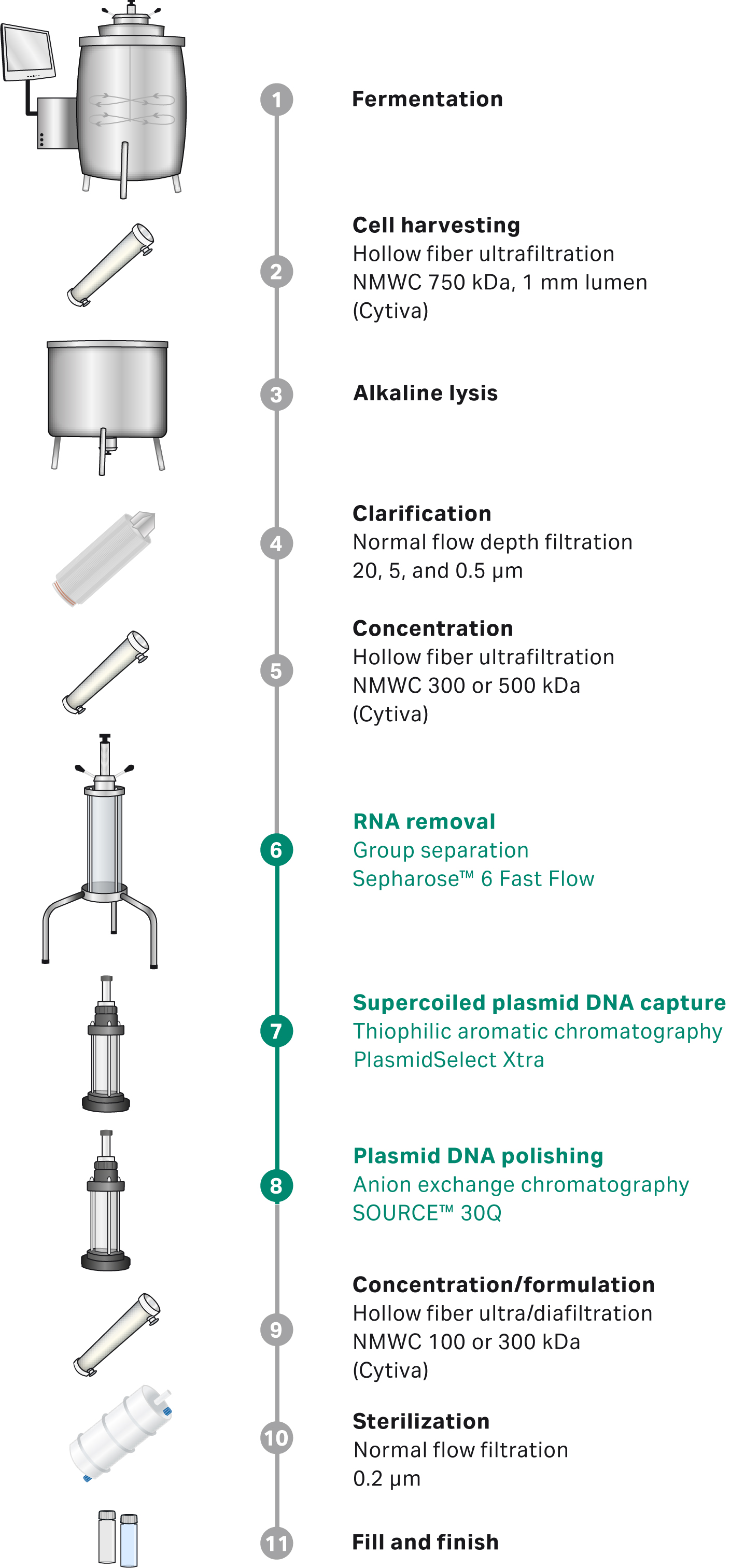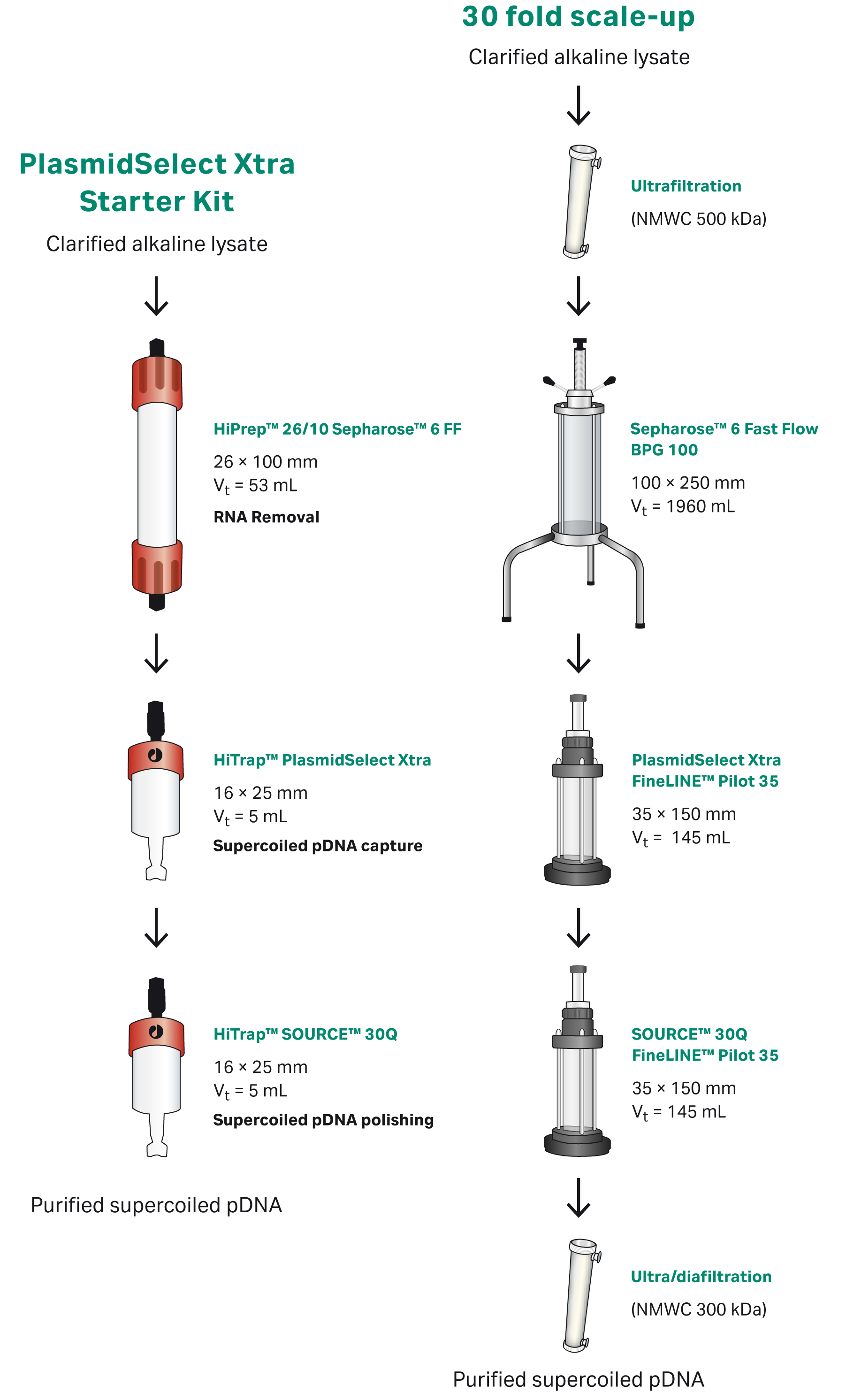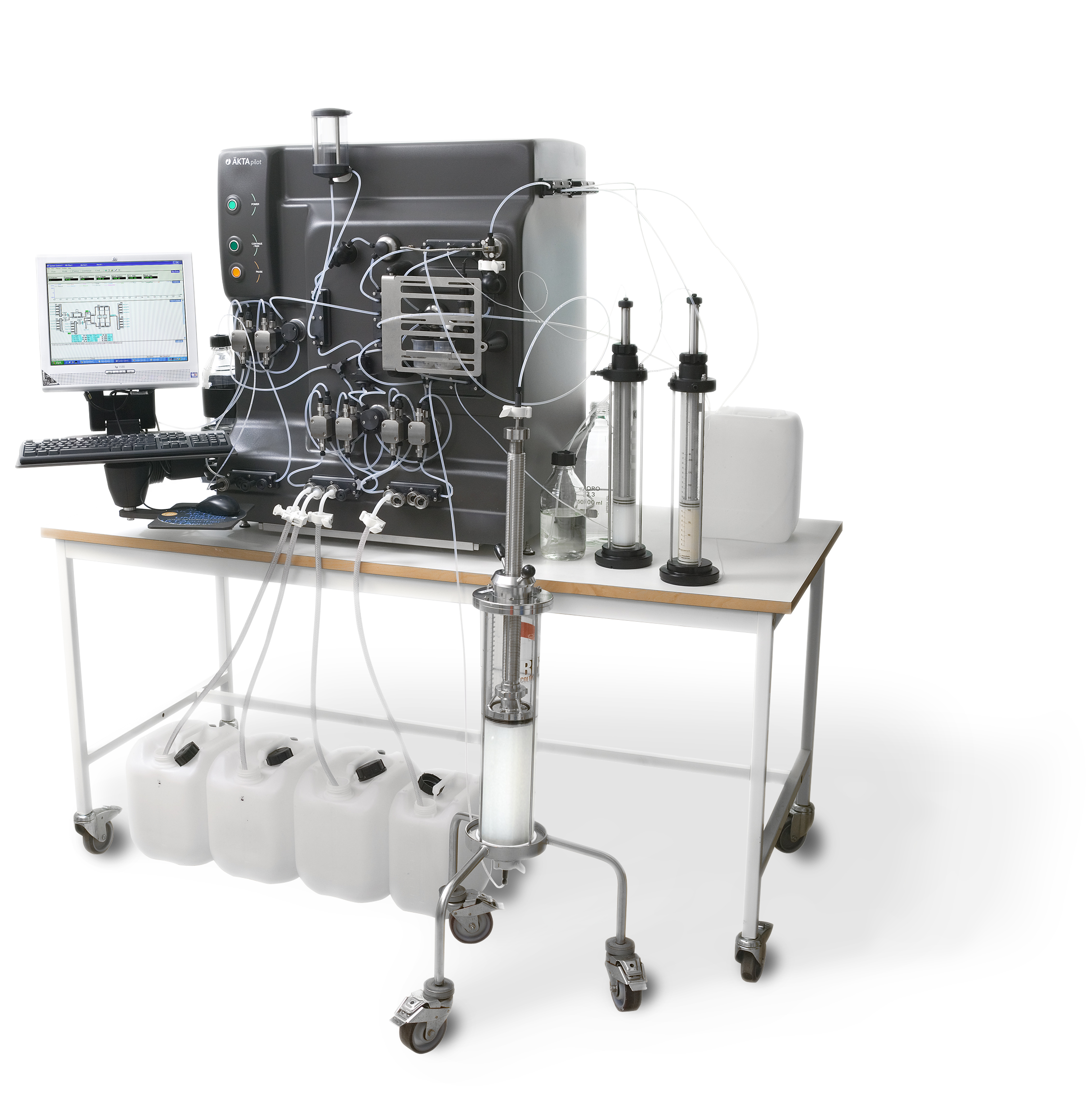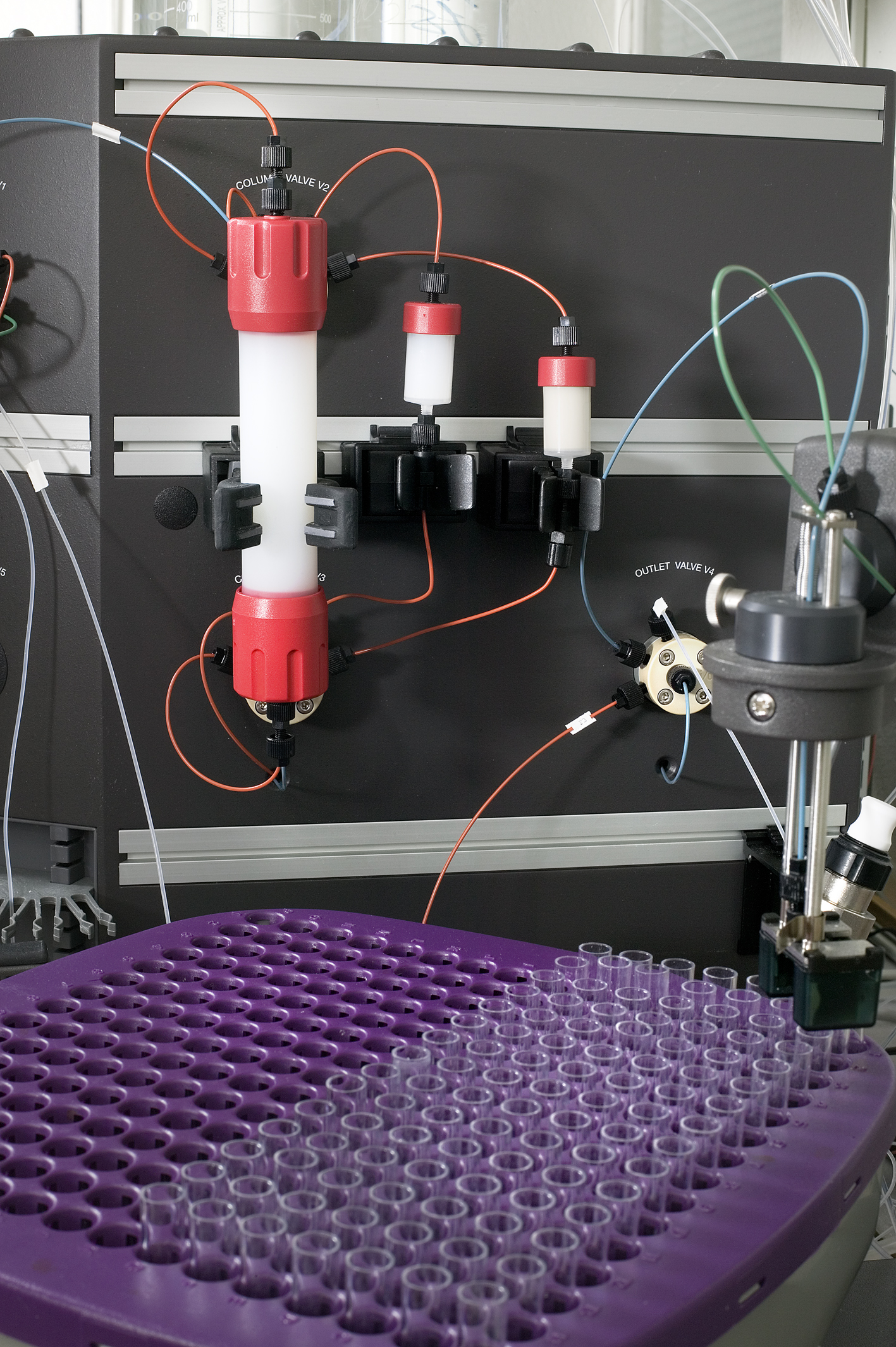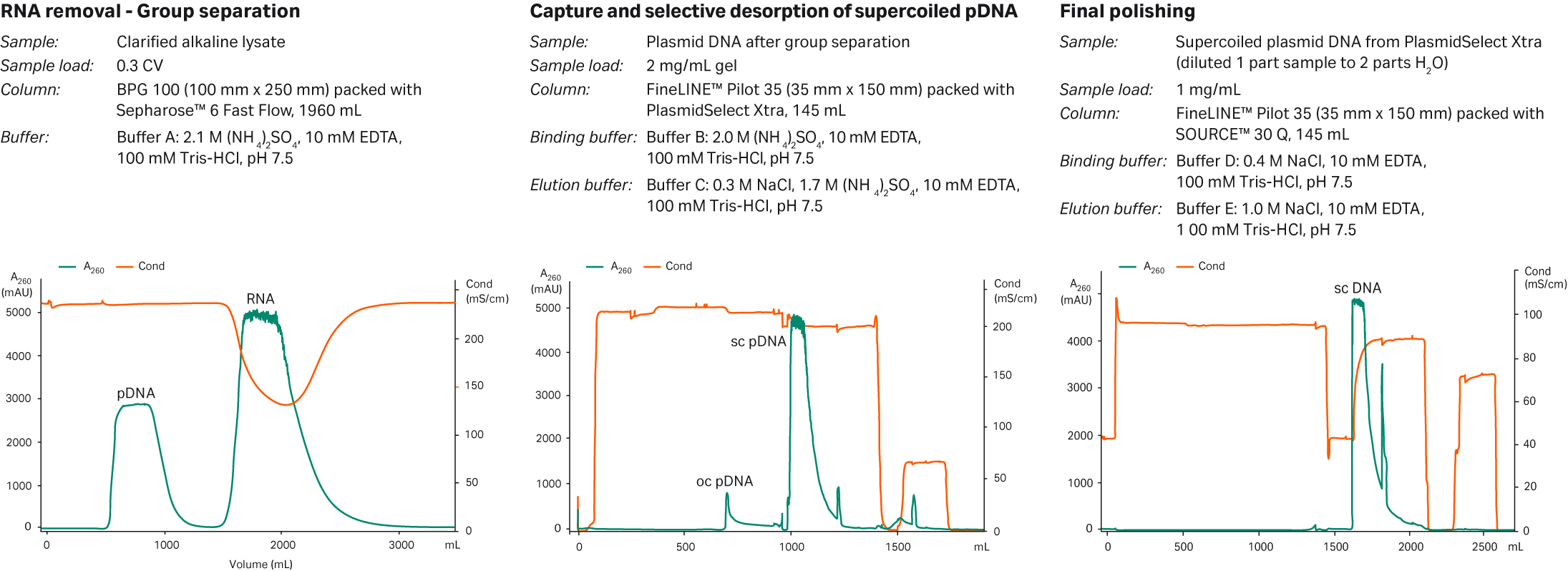Abstract
In 2006, a generic, three-step chromatographic process for purifying high-quality supercoiled (sc) plasmid DNA (pDNA) based on PlasmidSelect Xtra resin was developed for a 6.2 kb plasmid on the prepacked columns of the PlasmidSelect Xtra Starter Kit. Next, the process was scaled 30-fold to pilot operation on bulk chromatography resin packed in larger columns with ultra- and diafiltration steps added to adapt the process for large-scale manufacturing of supercoiled plasmid DNA.
PlasmidSelect Xtra is a BioProcess™ resin available in bulk and in prepacked columns in the PlasmidSelect Xtra Starter Kit. In 2018 PlasmidSelect Xtra was complemented with Capto™ PlasmidSelect, which allows for process intensification (i.e., better flow properties and the opportunity for a higher plasmid capacity). This product had the same ligand as PlasmidSelect Xtra.
The process based on PlasmidSelect Xtra comprises three chromatography steps:
- RNA removal and buffer exchange by group separation on Sepharose™ 6 Fast Flow
- Capture and selective desorption of supercoiled plasmid DNA with PlasmidSelect Xtra
- Final polishing on SOURCE™ 30Q*
* The final polishing can also be performed with Capto™ Q ImpRes, which is available in prepacked ReadyToProcess™ columns.
Scale-up was predictable, and the purity of the supercoiled DNA was comparable to that obtained with the prepacked columns. Furthermore, the downstream process was easy to integrate with filtration and the other unit operations. Further scale-up appears to be equally straightforward.
When fully optimized and adapted to manufacture, the integrated PlasmidSelect Xtra platform process yields high-quality plasmid DNA products suitable for clinical application.
The described three-step process is an excellent downstream workflow to generate high-purity supercoiled plasmid DNA. To intensify the downstream process, an alternative workflow can be considered. See the Process considerations section for more information.
Fig 1. PlasmidSelect Xtra forms the basis of a scalable, generic process for producing purified supercoiled DNA for gene therapy and DNA vaccination applications. The process is integrated with other unit operations such as cellular lysis, clarification, ultrafiltration, and diafiltration.
Introduction
PlasmidSelect Xtra and Capto™ PlasmidSelect chromatography resin are used in the key selective capture step of a generic three-step chromatographic process for the purification of supercoiled, covalently closed circular plasmid DNA. This process (Fig 1) is robust and can be scaled up to fulfill the requirements for the economical, industrial manufacture of plasmid DNA in highly regulated environments. It yields supercoiled plasmid DNA suitable for bulk to clinical-grade applications and can thus help meet the growing need for plasmid DNA products for use in gene therapy, DNA vaccination, and as template for in vitro transcription of mRNA.
This application note describes the use of PlasmidSelect Xtra resin to purify high-quality plasmid DNA from alkaline lysates of E. coli. It also shows how to scale up the purification from PlasmidSelect Xtra Starter Kit and highlights important process considerations. Figure 2 illustrates this general scale-up strategy. The data file contains more detailed product information.
Fig 2. The downstream process for purifying supercoiled plasmid DNA based on PlasmidSelect Xtra was developed with the starter kit and scaled up 30-fold to pilot scale with bulk resin.
We present basic experimental details of sample preparation and concentration, and then describe how a fast and efficient separation was developed with the PlasmidSelect Xtra Starter Kit before confirming the process details at pilot scale. Results were analyzed with regard to the ambition of using the PlasmidSelect Xtra platform to purify plasmid DNA of a quality suitable for gene therapy and related applications. Basic equipment, resin, and buffers are listed below.
Materials and methods
Sample
E. coli cell paste containing a 6.2 kb plasmid.
Chromatography columns
PlasmidSelect Xtra Starter Kit:
HiPrep™ 26/10 Sepharose™ 6 FF (53 mL)
HiTrap™ PlasmidSelect Xtra (5 mL)
HiTrap™ SOURCE™ 30Q (5 mL)
BPG™ 100, empty pilot-scale column FineLINE™ Pilot 35, empty pilot-scale column
Chromatography systems*
ÄKTA explorer™ 100 with UNICORN™ 5.01 software
ÄKTA pilot™ with UNICORN 5.01 software
*ÄKTA explorer™ and ÄKTA pilot™ are now discontinued and replaced by ÄKTA pure™ and ÄKTA avant™ and ÄKTA pilot™ 600.
Chromatography resin
Sepharose™ 6 Fast Flow, PlasmidSelect Xtra, SOURCE™ 30 Q
Filtration, ultrafiltration, and diafiltration
Watson-Marlow™ 520S pump
QuixStand Benchtop System (Cytiva)
Hollow-fiber cartridge, NMWC 500 kDa (Cytiva, UFP-500-C-5A, 500,000 NMWC, 2000 cm2)
Hollow-fiber cartridge, NMWC 300 kDa (Cytiva, UFP-300-C-3MA, 300,000 NMWC, 140 cm2)
20, 5, and 0.5 µm filters
0.2 µm filter
Diatomaceous earth (Sigma-Aldrich, D 3877)
Buffers
Buffer A: 2.1 M (NH4)2SO4, 10 mM EDTA, 100 mM Tris-HCl, pH 7.5
Buffer B: 2.0 M (NH4)2SO4, 10 mM EDTA, 100 mM Tris-HCl, pH 7.5
Buffer C: 0.3 M NaCl, 1.7 M (NH4)2SO4, 10 mM EDTA,
100 mM Tris-HCl, pH 7.5
Buffer D: 0.4 M NaCl, 10 mM EDTA, 100 mM Tris-HCl, pH 7.5
Buffer E: 1.0 M NaCl, 10 mM EDTA, 100 mM Tris-HCl, pH 7.5
High-purity water and chemicals were used. All buffers were filtered through a 0.22 µm or 0.45 µm filter.
Laboratory-scale purification
Sample preparation
E. coli cell paste was suspended in 50 mM Tris-HCl buffer, pH 7.5 (10 mL buffer/g cell paste), containing 10 mM EDTA (to reduce DNase activity) and approximately 50 mM glucose. Cells were then lysed with 1% SDS in 0.2 M NaOH (10 mL buffer/g cell paste), and cellular debris and SDS complexes flocculated by neutralization with ice-cold 3 M potassium acetate (10 mL buffer/g cell paste). The extract was clarified using filtration or centrifugation, depending on the scale (1).
*For improved plasmid recovery we now recommend lysation with 15 mL buffer/g cell paste at all scales.
This procedure normally gave an initial concentration of approximately 0.05 to 0.1 mg/mL plasmid DNA in the alkaline lysate.
The sample was filtered through a filter (1 or 5 µm) prior to application to the HiPrep™ 26/10 Sepharose™ 6 FF column.
Removal of RNA by group separation on Sepharose™ 6 Fast Flow (step 1)
HiPrep™ 26/10 Sepharose™ 6 FF was equilibrated with at least 110 mL (2 CV) of Buffer A at 5.3 mL/min (50 cm/h) and 16 mL (0.3 CV) of clarified cell lysate was loaded at the same flow rate. The void volume containing partially purified plasmid DNA preparation was collected for Step 2. The RNA-containing second (large) fraction was discarded. This procedure was repeated until all clarified alkaline lysate had been processed.
Capture and selective desorption of supercoiled plasmid DNA on PlasmidSelect Xtra (step 2a)
HiTrap™ PlasmidSelect Xtra (5 mL) was equilibrated with at least 10 mL (2 CV) of Buffer B at up to 4 mL/min (120 cm/h). The partially purified plasmid DNA sample from Step 1 was loaded at 3 mL/min (90 cm/h) and washed with 20 mL (4 CV) of Buffer B. The open circular (oc) forms of plasmid DNA eluted with the wash and the sc plasmid DNA was desorbed with 25 mL (5 CV) of Buffer C at up to 2 mL/min (60 cm/h). The peak containing the highly pure sc plasmid DNA was collected.
Final polishing on SOURCE™ 30Q (step 3)
HiTrap™ SOURCE™ 30Q (5 mL) was equilibrated with at least 10 mL (2 CV) of Buffer D at 4 mL/min (120 cm/h). The volume of the supercoiled plasmid DNA eluate from Step 2 was measured and diluted with two volumes of pure water to decrease the ionic strength. This diluted sample was loaded at 4 mL/min (120 cm/h), washed with at least 10 mL (2 CV) of Buffer D and eluted with at least 25 mL (5 CV) of Buffer E at 2 to 4 mL/min (60 to 120 cm/h). The eluted peak containing the purified supercoiled plasmid preparation was collected.
Pilot-scale purification
To adapt the purification to pilot-scale operation and to ensure further scale up when required, special consideration was given to a number of process steps and parameters.
The main measures taken are summarized below.
Fig 3. Scale-up of PlasmidSelect Xtra process with pilot-scale columns connected to an ÄKTA pilot™ system. ÄKTA explorer™ and ÄKTA pilot™ are now discontinued and replaced by ÄKTA pure™, ÄKTA avant™, and ÄKTA pilot™ 600.
Harvest, lysis, clarification, and concentration
To allow a smooth transition to an economical large-scale process, centrifugation was replaced by microfiltration for cell harvesting.
During alkaline lysis, special care was taken to ensure gentle mixing to avoid host cell chromosomal breakdown and formation of open circular plasmid DNA. The time from addition of alkali to neutralization with 3 M potassium acetate should not exceed 5 min to prevent irreversible denaturation of the plasmid DNA. These restrictions make the design of vessels and equipment critical parameters in process development.
Filtration of the neutralized alkaline lysate was performed in steps. First, the bulk of the flocculate was removed by crude filtration followed by addition of a filter aid (diatomaceous earth, 25 g/L) and bag filtration*. Final clarification was performed through a 20 µm and a 5 µm filter train.
Approximately 8 L of clarified lysate were concentrated 9-fold by ultrafiltration (Cytiva hollow fiber, 0.2 m2, NMWC 500 kDa, 2000 cm2, flux approx. 30 LMH, TMP approx. 3 psi) to a pDNA concentration of up to 1 mg/mL.
Process chromatography conditions
The same basic three-step purification process performed using the PlasmidSelect Xtra Starter Kit was run on the respective bulk resin packed in large-scale columns. Nevertheless, some extra considerations were taken into account.
Even though its capacity is higher, sample loading on the PlasmidSelect Xtra column was limited to 2 mg/mL to secure a low running pressure. A higher loading of the column has also been shown to have an adverse effect on purity. Pressure build-up during desorption of the column (due to the high viscosity of plasmid DNA at higher concentrations) was avoided by reversing the flow. Recovery was improved by pausing the run during elution.
The SOURCE™ 30Q final polishing step was not changed in comparison to the HiTrap™ SOURCE™ 30Q experiment, but recovery data (see results and discussion) showed that also here, performance can be improved by optimizing this chromatography step.
About 1 L of polished plasmid DNA product from SOURCE™ 30Q was concentrated and formulated to 4 mg/mL in phosphate buffered saline (PBS) by ultra/diafiltration (QuixStand Benchtop system with 140 cm2 hollow-fiber membrane,300 kDa NMWC). The final product was sterile filtered (0.2 µm) into sterile vessels.
Fig 4. ÄKTA explorer™ 100 system fitted with the prepacked columns of the PlasmidSelect Xtra Starter Kit. ÄKTA explorer™ and ÄKTA pilot™ are discontinued and replaced by ÄKTA pure™, ÄKTA avant™, and ÄKTA pilot™ 600.
Fig 5. Purification of supercoiled plasmid DNA from a clarified alkaline lysate using the PlasmidSelect Xtra Starter Kit. oc = open circular; sc = supercoiled.
Table 1. Analysis of fractions from the purification of a 6.2 kb plasmid (Fig 5)
| Sample /mL) | pDNA (µg | scDNA* (%) | Endotoxin† (EU/mg pDNA) | HCP‡ (µg/mg pDNA) | gDNA§ (µg/mg pDNA) | RNA¶ (µg/mg pDNA) | Recovery (%) |
| Start material alkaline lysate | 130 | 92 | 90 000 | 36 000 | 16.8 | n.d. | 100 |
| Sepharose™ 6 Fast Flow | 129 | 94 | 10 000 | < 39** | 0.54 | 0.0 | 92 |
| group-separated material PlasmidSelect Xtra supercoiled pDNA | 606 | 98 | 220 | < 8** | 0.34 | 0.0 | 72 |
| SOURCE™ 30Q polished material | 574 | 98 | 1.6 | < 9** | 0.32 | 0.0 | 57 |
* Supercoiled plasmid DNA determined by capillary gel electrophoresis.
† Endotoxin determined by limulus amoebocyte lysate chromogenic endpoint assay.
‡ Host cell protein determined by bicinchoninic acid protein assay.
§ Host cell chromosomal DNA determined by TaqMan PCR.
¶ RNA determined by TaqMan PCR.
** Below detection limit (< 5 µg/mL).
The analyses were performed by PlasmidFactory, Bielefeld, Germany (www.PlasmidFactory.com).
Results and discussion
Laboratory-scale purification
Figure 5 shows the chromatograms obtained from the three-step process for the purification of supercoiled plasmid DNA with the prepacked columns of the PlasmidSelect Xtra Starter Kit run on ÄKTA explorer™ 100 (Fig 4 and 5).
Analytical agarose electrophoresis (Fig 6) reveals the excellent separation of sc and oc forms of plasmid DNA, thus confirming the basic principle of using PlasmidSelect Xtra as the key selective step. Table 1 lists key analytical data for the purified samples obtained with the starter kit.
Pilot-scale purification
Figure 7 shows the chromatograms obtained after an approximately 30-fold scale up to pilot-sized operation on an ÄKTA pilot™ system.
The pilot-scale purification produced plasmid DNA with a purity comparable to that obtained with the PlasmidSelect Xtra Starter Kit (Table 2). Optimizing desorption conditions from PlasmidSelect Xtra at pilot scale together with the improved performance of SOURCE™ 30Q at larger scale, resulted in a noticeable increase in recovery, boosting total recovery almost 20%.
Fig 6. Ethidium bromide stained 0.8% agarose electrophoresis gels indicate the purity of the fractions obtained after the different steps in Fig 5. M = molecular weight marker, oc = open circular, sc = supercoiled.
Fig 7. Scaled-up purification of supercoiled plasmid DNA on ÄKTA pilot™ system. The three BioProcess™ resins (Sepharose™ 6 Fast Flow, PlasmidSelect Xtra, SOURCE™ 30Q) were packed in pilot-scale columns. oc = open circular; sc = supercoiled.
Table 2. Analytical data for the purified samples from the pilot-scale run on ÄKTA pilot™ system (non-GMP conditions; Fig 7)
| Sample | pDNA (µg/mL) | scDNA*(%) | Endotoxin† (EU/mg pDNA) | HCP‡ (µg/mg pDNA) | gDNA§ (µg/mg pDNA) | RNA¶ (µg/mg pDNA) | Recovery (%) |
| Concentrated alkaline lysate | 460 | 86 | 150 000 | 36 000 | 0.95 | n.d. | 100 |
| Sepharose™ 6 Fast Flow group-separated material | 339 | n.d. | 3 | n.d. | n.d. | 0.6 | 99 |
| PlasmidSelect Xtra supercoiled pDNA | 235 | 98 | 4 | < 17** | 0.3 | 0 | 89 |
| SOURCE™ 30Q polished material | 298 | 98 | < 17** | < 1** | 0.02 | 0.01 | 78 |
| Final product (after 0.22 µm filtration) | 4560 | 98 | < 0.1** | < 1** | 0.02 | 0.01 | 69 |
* Supercoiled plasmid DNA determined by capillary gel electrophoresis.
† Endotoxin determined by limulus amoebocyte lysate chromogenic endpoint assay.
‡ Host cell protein determined by bicinchoninic acid protein assay.
§ Host cell chromosomal DNA determined by TaqMan PCR.
¶ RNA determined by TaqMan PCR.
** Below detection limit (< 5 µg/mL).
The analyses were performed by PlasmidFactory, Bielefeld, Germany (www.PlasmidFactory.com).
Process considerations
Fermentation
The PlasmidSelect Xtra process purifies supercoiled plasmid DNA based on the selective removal of open circular plasmid DNA from PlasmidSelect Xtra by the wash buffer.
Consequently, the amount of supercoiled plasmid DNA purified is directly related to amount present in the starting material (i.e., the fermentation broth). Optimizing the fermentation with respect to plasmid DNA quantity and quality should therefore be considered. Current fermentation techniques with optimized bacterial strains produce up to 1.5 g of plasmid DNA per liter of bacterial culture and only contain 5% to 10% of open circular plasmid DNA (2).
Sample preparation
It is also very important to optimize the alkaline lysis to avoid introducing the nicked plasmid isoform in the sample.
The scale, methodology, and equipment used for alkaline lysis must be carefully considered to obtain an optimal neutralized lysate. In particular, mixing at alkaline pH must be kept smooth and short.
Removing flocculate at scale can be a challenge, but adding a filter aid and using filter trains are scalable ways to overcome this. The classical and well-established combination of filter aid and bag filtration used in this application proved to be robust and delivered reliable results. Final clarification through a 20-µm and a 5-µm filter also worked well.
*At least for large scales we now recommend performing a RNA precipitation step with CaCl2 to decrease the amount of RNA, followed by an initial clarification using flocculation lift, which removes the bulk of the flocculates which greatly simplifies filtration and hence removes the need for diatomaceous earth (reference below).
(Flocculate removal after alkaline lysis in plasmid DNA production, Hans Blom, Mia Bennemo, Mikael Berg, Raf Lemmens 2010 Dec 10;29(1):6-10. doi: 10.1016/j.vaccine.2010.10.021. Epub 2010 Oct 23.
Ultrafiltration of the clarified alkaline lysate is a powerful, fully scalable method that both concentrates and partially purifies the sample. In the pilot-scale work reported here, the sample started to become opalescent at 9-fold concentration. This opalescence is caused by the increasing concentration of plasmid DNA, which in this case was measured to be almost 1 mg/mL, and RNA. Analysis of the precipitate by chromatography showed that it consisted mainly of RNA. No plasmid DNA was visible.
Although such precipitation can be removed by filtration, this adds an extra step to the process without necessarily improving the productivity. We therefore recommend choosing a concentration factor that avoids RNA precipitation. The concentration factor to select, however, very much depends on the bacterial strain, fermentation conditions, and plasmid DNA concentration. As such, no general recommendation can be made.
Novel quicker process with less ammonium sulfate
There is now a two-step plasmid purification process that you may choose to adopt. The process includes an 80% reduction in production time for downstream processing and an increased sustainability (50% reduction in ammonium sulfate consumption). There is efficient reduction of CaCl2 participation during lysis. This novel process includes reproducible and rapid cycling using Mustang™ Q XT membrane capsules and successful purification of supercoiled pDNA using the Capto™ PlasmidSelect resin.
Pilot-scale chromatography
Group separation on Sepharose™ 6 Fast Flow (Step 1) is a very powerful method for both removing RNA and conditioning the sample for the next chromatography step. As with any chromatography step, it is important to ensure that the sample is free from precipitate to avoid clogging the column net. Because of the risk of RNA precipitation during the preceding ultrafiltration step (see above), this is of particular importance here. We thus suggest considering the use of a pre-column filter.
With a maximum loading of 2 mg/mL of resin, purification of plasmid DNA on PlasmidSelect Xtra (Step 2) showed a recovery of around 90% at pilot scale. The strategy of eluting with pauses followed by reversed flow resulted in a high recovery in a low volume.
Final polishing on SOURCE™ 30Q (Step 3) had a significantly lower recovery than PlasmidSelect Xtra. Sample application conditions appear to be critical to obtaining good recovery. Loadings in the range 1 to 3.4 mg plasmid DNA/mL resin gave recoveries of 68% to 78% at pilot scale. Recovery at this step and for the process as a whole can be improved considerably by further optimizing the different steps with respect to sample concentration and loading, as well as concentration factors and flow rates.
Conclusions
The three-step chromatography process for purifying plasmid DNA based on PlasmidSelect Xtra resin resulted in a final product of high quality. The workflow, first applied on the PlasmidSelect Xtra Starter Kit, was scalable to bulk resin packed in pilot-scale columns. Furthermore, the chromatographic part of the process was easy to integrate with different filtration steps to obtain a fully integrated process for large scale manufacturing. Its generic nature and overall robustness suggest that it will work well with a variety of plasmids.
When fully optimized and adapted to manufacturing requirements, the PlasmidSelect Xtra process should be suitable for the economic production of high-purity plasmid DNA for clinical applications.
Mustang is the trademark of Global Life Sciences Solutions USA LLC or an affiliate doing business as Cytiva. TaqMan is a registered trademark of Roche Molecular Systems. Inc. Watson-Marlow is a trademark of Watson Marlow Limited. Any other third-party trademarks are the property of their respective owners.
References
- Sambrook J, Russel DW. Molecular cloning. A laboratory manual., Cold Spring Harbor Laboratory Press, Cold Spring Harbor, NY; 2001.
- Carnes AE, Hodgson CP, Williams JA. Inducible E. coli fermentation for increased plasmid DNA production. Biotechnol Appl Biochem. 2006;45(Pt3):155-166. doi:10.1042/BA20050223.
